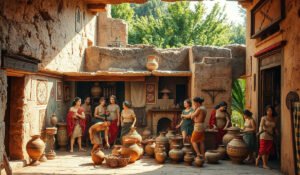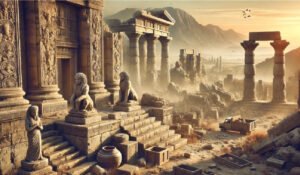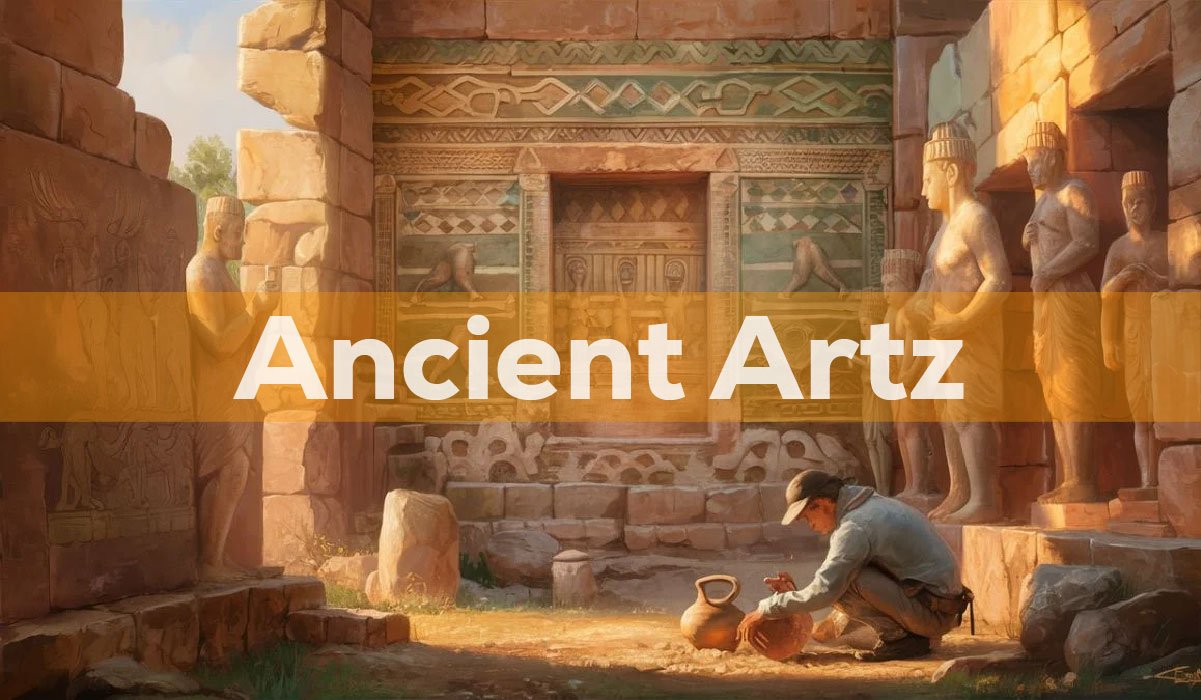When we think about the artworks from centuries ago, it’s not just the aesthetic charm or historical value that captivates us; it’s their ability to act as a portal into the lives of ancient civilizations. Ancient Artz, encompassing a vast range of creative expressions from the prehistoric era to the classical antiquity of the Roman Empire, offers an insightful glimpse into our shared past. It showcases how our ancestors interpreted the world around them, celebrated their cultural traditions, and expressed their deepest beliefs and desires through art.
This article aims to explore the profound impact of ancient art, journeying through different regions and eras, examining their unique contributions, and understanding the enduring legacy that continues to influence modern art and culture.
The Breadth of Ancient Artz
The journey of ancient art begins as early as 40,000 years ago, with the simple yet profound cave paintings of the Upper Paleolithic era, and spans through the sophisticated sculptures and monumental architectural achievements of classical antiquity. Across this vast timeline, every region of the world contributes uniquely, utilizing local materials and indigenous techniques to craft pieces that stand the test of time. From the ziggurats of Mesopotamia to the pyramids of Egypt, and from the classical sculptures of Greece to the intricate bronzes of China, each civilization added its thread to the tapestry of ancient art, creating a diverse heritage of human creativity.
Civilization Highlights and Their Artistic Contributions

The Mesopotamian Innovations
Mesopotamia, often hailed as the cradle of civilization, gives us some of the earliest records of human art. The region was a melting pot of cultures including the Sumerians, Akkadians, Assyrians, and Babylonians, each leaving behind a treasure trove of artifacts. These cultures are well-known for their stone reliefs and intricate cylinder seals which were not only artistic expressions but also served practical purposes like sealing documents. The Stele of Hammurabi, for instance, is a remarkable basalt monument that combines art with law, inscribed with codes that governed the society of that time.
Eternal Egyptian Art
Moving to the banks of the Nile, Egyptian art remains one of the most recognizable ancient arts. Characterized by its highly stylized and symbolic nature, Egyptian art was primarily religious, created to ensure immortality after death. This is best exemplified in the grand structures like the Great Sphinx and the Pyramids of Giza—monuments that were as much tombs as they were testaments to divine kingship. The detailed wall paintings within these structures depicted everyday Egyptian life and believed rituals, giving us insights into their daily activities and spiritual beliefs.
Greek Art: The Pursuit of Perfection
The Greeks took a different approach by celebrating the human form, seeking idealized beauty through balance and proportion. This pursuit led to the creation of sculptures that emphasized anatomical precision and dynamic poses, as seen in masterpieces like the Discobolus and the Venus de Milo. Greek architecture, particularly the Doric, Ionic, and Corinthian columns, showcases an understanding of form and function that has significantly influenced Western architecture.
Roman Realism and Engineering Prowess
Roman art, while heavily influenced by the Greeks, focused more on realism and practical applications, evident in their sculptures and vast architectural projects. Roman engineers introduced innovations such as concrete, which allowed for the construction of iconic structures like the Pantheon and the Colosseum. Their art was not just for aesthetic enjoyment but served public, civic, and domestic functions, reflecting the empire’s complex social and political structure.
Diverse Artistic Expressions Across Asia
In Asia, ancient art varied significantly from China to India. Chinese art is renowned for its spiritual and natural motifs, heavily influenced by Taoism and Confucianism. The Terracotta Army, buried with Emperor Qin Shi Huang, showcases the precision and scale of ancient Chinese craftsmanship. Indian art, on the other hand, is best represented by the elaborate temple carvings and statues that adorn places like the Ajanta Caves, which are filled with murals and sculptures that narrate tales of Buddha’s life.
Themes and Symbolism in Ancient Artz
The art of these ancient civilizations was never just about beauty or decoration; it was deeply symbolic, reflecting the community’s values, beliefs, and social hierarchy. For instance, in Egyptian art, the pharaohs were often depicted at a much larger scale than ordinary figures, symbolizing their god-like status. Similarly, Greek art often used mythology to explore themes of heroism and morality, a reflection of their societal ideals.
Enduring Impact of Ancient Artz on Modern Culture
Ancient art profoundly impacts modern culture, influencing everything from architectural design to the philosophical underpinnings of contemporary societies. Architectural elements such as the Greek columns and Roman arches have been seamlessly integrated into modern buildings, reflecting an enduring legacy that emphasizes symmetry, function, and beauty. These classical designs continue to resonate in today’s architectural styles, from government buildings to educational institutions, showcasing the timeless appeal and practicality of ancient innovations.

Furthermore, ancient artworks offer rich narratives that continue to inspire modern media, including literature, film, and visual arts. Mythological themes and symbolic motifs from ancient Egypt, Greece, and Rome are woven into contemporary storytelling, providing a universal language that transcends time and cultural barriers. This cultural continuity not only enriches artistic expressions but also helps maintain a connection to our historical roots, highlighting the deep human desire to explore and understand the existential questions that have shaped human civilization since its dawn.
The Role of Materials and Techniques in Ancient Artz
Artists of ancient times were limited by the materials available in their natural environment, yet they often turned these limitations into strengths. In Mesopotamia, the abundant clay led to the development of pottery and bricks, while in Greece, the prevalent marble was transformed into statues that have captivated the world. The techniques evolved over time, from basic carving and modeling to more complex methods like bronze casting and fresco painting, allowing for greater expression and detail.
Preservation and Modern Discoveries
One of the biggest challenges in the study of Ancient Artz is preservation. Environmental conditions, human conflicts, and time have all taken their toll on these ancient works. However, modern archaeology and technology have played crucial roles in the preservation and understanding of these artifacts. Techniques like carbon dating, 3D mapping, and digital reconstructions have revolutionized our ability to study and preserve ancient art forms.
Conclusion: The Lasting Impact of Ancient Artz
Ancient art does more than beautify our museums; it offers us a window into the past, providing insights into the lives, beliefs, and environments of our ancestors. It serves as a reminder of our shared human heritage and continues to influence modern culture in myriad ways. From architecture and sculpture to literature and film, the legacy of ancient art permeates our daily lives, ensuring that these ancient civilizations continue to inspire and teach us centuries after their decline.
Frequently Asked Questions About Ancient Artz
What is considered Ancient Artz?
Ancient Artz refers to the art produced by early civilizations from the prehistoric period up until the early Middle Ages, before the fall of the Roman Empire. This includes cave paintings, sculptures, architectural structures, and other decorative arts created during the Stone Age, Bronze Age, Iron Age, and classical periods across various cultures worldwide.
Which civilizations are most noted for their contributions to Ancient Artz?
Key civilizations known for their contributions to ancient art include the Egyptians, Greeks, Romans, and Mesopotamians, each renowned for unique artistic styles and innovations. Other significant contributions came from ancient China, India, and various Mesoamerican cultures like the Maya and Aztecs.
How did Ancient Artz influence modern art and architecture?
Ancient art has profoundly influenced modern art and architecture, providing foundational principles like symmetry, proportion, and the use of columns in architecture. Ancient Greek and Roman aesthetics have been particularly influential, inspiring Renaissance artists and continuing to impact contemporary design and architectural styles.
What types of materials were commonly used in Ancient Artz?
The materials used varied widely by region and period but commonly included stone (such as marble and limestone), metals (like bronze and gold), clay, wood, and various pigments for painting. These materials were chosen for their availability, durability, and the symbolic meanings they could convey.
Why is it important to study Ancient Artz today?
Studying ancient art helps us understand the cultural, religious, and social values of different civilizations throughout history. It provides insights into human creativity and technological advancements and helps us appreciate the diversity and interconnectedness of human cultures. Additionally, ancient art can offer inspiration for modern artists and designers, allowing them to incorporate time-tested aesthetic principles and themes into contemporary works.
How do archaeologists and historians determine the age of ancient artworks?
Archaeologists and historians use various dating methods to determine the age of ancient artworks, including carbon-14 dating for organic materials, thermoluminescence dating for ceramics, and stratigraphy which examines the layers of earth in which objects are found. These techniques help provide accurate estimates of when the artworks were created.
What were the common themes explored in Ancient Artz?
Common themes in ancient art include religion, mythology, power, and daily life. Artworks often depicted gods and goddesses, mythological scenes, scenes of warfare, royal figures, and aspects of daily life such as agriculture, hunting, and domestic activities. These themes were not only decorative but also served to communicate cultural values and beliefs.
How has ancient art been preserved and protected over the centuries?
Ancient art has been preserved through a combination of natural conditions, such as dry or sealed environments that prevent decay, and human efforts, including restoration and conservation practices. Museums and cultural heritage organizations play a crucial role in protecting ancient artworks from environmental threats and vandalism, using modern technology to monitor and preserve these treasures.
Can you explain the significance of symbolism in Ancient Artz?
Symbolism was a crucial element in Ancient Artz, as many cultures used symbols to represent abstract ideas, religious beliefs, or social status. For example, in Egyptian art, the ankh symbolized life and regeneration, while in Christian iconography, the fish symbolized Christ. Understanding these symbols gives deeper insight into the values and beliefs of ancient peoples.
What impact did trade and cultural exchanges have on Ancient Artz?
Trade and cultural exchanges had a significant impact on ancient art, as they facilitated the spread of materials, artistic techniques, and styles across different regions and cultures. For example, the spread of Hellenistic art throughout the Mediterranean and into Asia was propelled by Alexander the Great’s conquests, which blended Greek artistic styles with local traditions, resulting in a rich fusion of influences that enriched Ancient Artz.
















Leave a Reply